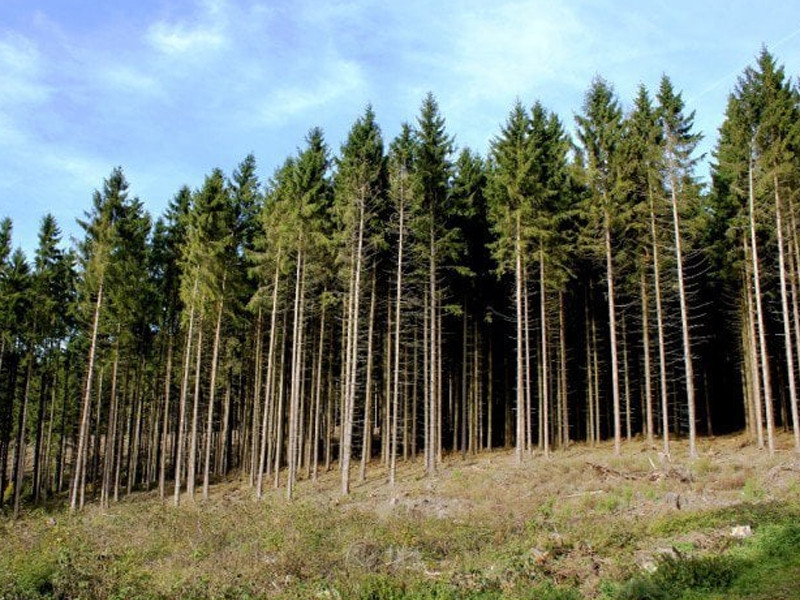
Khyber-Pakhtunkhwa (K-P), with 40% of the country's forests, covers 14.10% of the land area (Kahlon & Talal 2020). The terrain of K-P is mostly mountainous to the north, northwest, and east. These forests are the source of water for major rivers flowing from north to south. They offer the richest habitat for biodiversity, tourism, natural beauty, and help stabilise the impacts of climate change on humans and other biota. These forests may also be called the lungs of the country as they supply oxygen and remove carbon dioxide from the air through carbon sequestration. Therefore, these forests play an essential role in balancing the environment across time and space. Besides these goods and services, forests also provide food, shelter, and fruit to humanity at large.
Most of the natural forests in K-P belong to local communities and are managed by the Forest Department. The International Union for Conservation of Nature (IUCN) has reported that government-owned forests constitute only 7% of the forested land, while 93% belongs to the people and communities. The legal forest categories in K-P include reserved forests, which are the sole property of the government of K-P. Protected and Guzara forests, in fact, belong to local people and communities but are managed by the Forest Department. In addition to these legal forest types, there are also community and private forests. In a recent development in the early seventies, the K-P Forest Department planted trees and undertook soil conservation activities on private waste/grazing lands in the Tarbela watershed, aiming to reduce erosion and enhance the life of the Tarbela reservoir. An agreement was signed with the landowners, allowing the watershed management arm of the K-P Forest Department to plant tree species, fruit trees, and conduct soil conservation activities.
Most of the tree species planted are coniferous trees like Chir Pine, Kial, Deodar, and other species suited to the local ecological conditions of the site. Conifers are banned under forest law, and even privately grown conifer trees cannot be cut, transported, or sold without the prior permission of the Forest Department. Now that most of the watershed plantations have reached harvestable age for thinning or felling, the landowners want to exploit these forests for their benefit, but forestry rules do not allow any such exploitation. Therefore, a woodlot policy was approved in 2017 and implemented by the K-P Forest Department to allow the cutting and sale of private forests by the owners under certain terms and conditions, including the payment of government timber export duty. Consequently, owners and timber contractors rushed to grab their share of benefits from the woodlot policy. Seeing the opportunity, department staff also started getting their share, leading to a "woodlot honeymoon" for a few years until it was recently banned.
Wood cut under the woodlot policy is stacked on roadsides inside jungle roads, and some were in transit to down-country markets for sale. However, the ban was imposed in a surprising manner in early July 2024, halting all activity. Two Divisional Forest Officers (DFOs) were suspended for issuing Transport Passes for timber on roads and in transit after the ban was imposed. This sudden and overnight ban is neither fair nor sustainable for forestry plantations or the Forest Department. This shock has further shaken the trust and confidence among the owners, local communities, and the Forest Department. Forests are vast, open areas without walls or locks, and aside from the Forest Department's internal protection staff, local communities play an important role in forest protection, firefighting, and tree plantation drives. Such actions have strained the existing relations between the Forest Department and its stakeholders.
Earlier, the government of K-P approved and implemented the Forest Cooperative Societies policy in the early eighties, allowing the owners of the Guzara forests in Hazara to form Forest Cooperative Societies to exploit and sell timber from their owned Guzara forests. The policy was ideal in theory but very poorly implemented, as political and other elites took control of the Forest Cooperative Societies and, in connivance with the forestry staff, ruthlessly exploited precious forests. The 1992 floods exposed their illicit forest exploitation by bringing logs to the scene in the floodwaters all around. Consequently, the then Prime Minister of Pakistan imposed a ban on timber cutting. The Forest Cooperative Societies were also banned, ending the policy suddenly and unexpectedly.
This dilemma of makeshift forest policiesconceived, implemented, and then banned without any assessment of needs and feasibilityis proving more dangerous for the forestry enterprise. Forestry, being a long-term enterprise, requires long-term policy and planning. There is a need for sustainable forest policies and plans based on ground realities and in consultation with the owners, local communities, and other stakeholders. Forestry is a science involving living beings, trees, plants, wildlife, and biodiversity, and their conservation and management should be conducted on a scientific basis. Emerging climate change factors and phenomena have further increased the demand for science-based forestry practices. Therefore, foresters must understand these realities and move away from their age-old traditional forest management, policies, and planning regimes, and adapt to the current day's emerging forestry practices.
Forestry goods, such as timber extraction, are not a crime if conducted at the appropriate rotation age when the forest wood has captured maximum carbon from the atmosphere and stored it as wood, which should then be cut and used in a scientific manner. If such wood is allowed to degrade in the open, it may emit greenhouse gases back into the atmosphere, which is against the provisions of the UN Framework Convention on Climate Change (UNFCCC) ratified by Pakistan. Therefore, we must understand these dynamics to support foresters in pursuing the science of forestry for the benefit of humanity and the environment. The sustainability of forestry practices and their respective policies and plans is essential for ensuring that forestry serves the ecosystem, environment, climate change, and humanity at large.
THE WRITER HOLDS A PHD IN FOREST MANAGEMENT AND HAS SERVED THE KP FOREST DEPARTMENT BEFORE JOINING THE CIVIL SERVICE OF PAKISTAN



1730803801-0/BeFunky-collage-(22)1730803801-0-165x106.webp)

1728377970-0/Menendez-Brothers-(1)1728377970-0-165x106.webp)










1730706072-0/Copy-of-Untitled-(2)1730706072-0-270x192.webp)
COMMENTS
Comments are moderated and generally will be posted if they are on-topic and not abusive.
For more information, please see our Comments FAQ